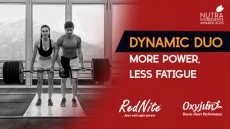New research questions 20 gram protein intake limit during post-exercise recovery

Writing in the journal Cell Reports Medicine, researchers from Maastricht University Medical Centre in the Netherlands reported that "the magnitude and duration of the anabolic response to protein ingestion is not restricted and has previously been underestimated in vivo in humans."
Stated otherwise: There’s no ceiling to the protein the human body can absorb in post-resistance training.
Although 20 g of protein is adequate to support muscle growth, this latest research confirms previous evidence debunking the 20 g as upper protein limit.
Study details
Current guidelines suggest that people should distribute protein intake evenly throughout the day, with each meal containing no more than 20-25 g of protein, the study noted.
“Though this makes sense based on typical dietary intake patterns in humans, it seems to be at odds with the feeding practices of many animal species in nature that consume large amounts of food infrequently,” the researchers wrote. “This is most notable in snakes, in which the ingestion of a large meal results in prolonged protein digestion, amino acid absorption and elevated protein synthesis rates, with only 5% of the ingested protein being directed toward amino acid oxidation.”
When ingesting larger amounts of protein, a short timeframe will likely be insufficient to allow complete digestion and amino acid absorption and does not provide a reliable assessment of protein handling after meals, they added.
The study broke participants down into three groups to assess the time of protein handling on a whole-body, muscle-tissue and myocellular level in response to consumption of moderate and large (25 and 100 g) of milk protein following exercise. The third group was placebo. A quadruple isotope tracer feeding-infusion approach was used to assess metabolic processes, combined with frequent plasma and muscle tissue sample collection over a 12-hour period.
The data demonstrated that the ingestion of a large amount of protein results in prolonged protein digestion, amino acid absorption and continued amino acid release into the circulation, confirming the study's hypothesis.
"This work highlights that tissues have a much higher capacity to incorporate exogenous-protein-derived amino acids than previously assumed and that the duration of the post [meal] period is proportional to the size of the ingested meal," the researchers concluded. "Subsequently, amino acids are taken up into tissues, are incorporated into tissue protein, and increase whole-body protein balance proportional to the ingested amount of protein."
Limitations
The study acknowledged the possibility that the metabolic response to protein ingestion could be modified over time. For instance, amino acid oxidation may increase in response to frequent, prolonged episodes of [having excess amino acids in the bloodstream] or that large post-[meal] protein gains are “compensated for by upregulation of amino acid oxidation in a subsequent fasted state".
However, the researchers noted that the data provided "a mechanistic explanation for why larger but less frequent meals are a viable alternative to consuming smaller meals more frequently.”
They added that it may not be possible to extrapolate their observations in healthy, young men to other populations and/or conditions, stating that more clinically compromised individuals may experience "a ceiling response in the magnitude and/or duration of the anabolic response to protein ingestion."
Source: Cell Reports Medicine
doi: doi.org/10.1016/j.xcrm.2023.101324
“The anabolic response to protein ingestion during recovery from exercise has no upper limit in magnitude and duration in vivo in humans”
Authors: Jorn Trommelen et al.













